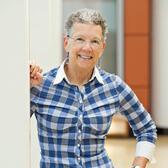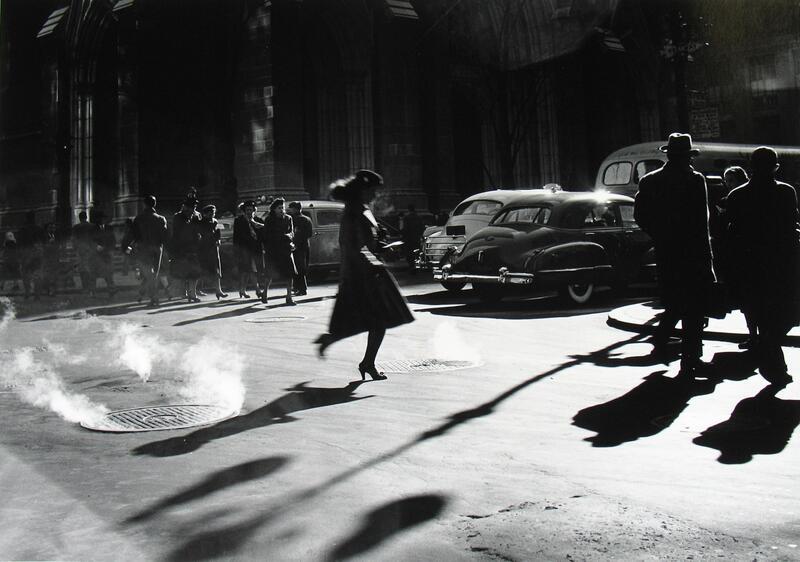From the Archive: Rebecca Lepkoff, "Midtown Manhattan" (1947)
What We Found
Take a look at this 1947 photograph by Rebecca Lepkoff, Midtown Manhattan, from The Posen Library of Jewish Culture and Civilization. It captures a woman clad in heels, hat, and knee-length coat or dress running across the street. She seems to dance on an urban stage. To her left, steam rises theatrically from a manhole cover. Pedestrians walk in the background, and two men cross the road on the right. The shadows of the woman, the two men, and a streetlight extend across the photograph’s foreground. The woman’s foot, the steam, and the shadows appear fluid and diffuse. The street sign in the photograph’s upper right corner identifies the spot: “W. 51st Street,” an east-west crosstown street in midtown Manhattan, a long way from the Lower East Side, where Lepkoff grew up.
Rebecca Lepkoff’s parents, Isadore Brody and Anna Rose Schwartz, immigrated from Minsk to New York City in 1910. Born in New York in 1916, Rebecca lived with her parents and five siblings in the tenements of the Lower East Side. As a teenager, Lepkoff took gymnastics classes and played sports at the Educational Alliance, a social institution founded in 1889 as a partnership between the Aguilar Free Library, the Young Men’s Hebrew Association, and the Hebrew Institute. The Educational Alliance is where Lepkoff first took dance classes. Soon, Lepkoff was working in the garment industry and dancing with Bill Maton’s experimental dance company during the slow season. Eventually, as Peter E. Dans and Suzanne Wasserman explain in their book Life on the Lower East Side, Lepkoff’s passion for dance propelled her to pick up a camera to portray the fast-paced movement of the streets of New York.
Why It Matters
In 1939, the World’s Fair hired Lepkoff to dance in a performance about the history of railroads, where she earned actors’ equity pay based on union scale wages. Using that money, she bought a used camera and turned her attention from the stage to the streets of the Lower East Side. She hung out in her familiar neighborhood, pointing her camera at her working-class neighbors and their children who played in the streets. In the evenings, she developed her photographs in her tenement bathroom.
The camera gave Lepkoff the freedom to stare at people. At the same time, her position as a Jewish woman in her own neighborhood granted her the ability to blend in. As a silent observer, Lepkoff captured the street vendors, garment workers, and butchers in portraits and candid photographs, against the backdrop of the city. In 2009, Lepkoff told an interviewer that her dance training attuned her to “the choreography of the movement of the streets.”
In 1946, Lepkoff enrolled in a photography class with Arnold Eagle, another documentary photographer, who introduced her to the New York Photo League, a cooperative of photographers invested in social and creative causes. The League and its members—one-third of whom were women—sought to meld formal elements of design and composition with the realities of the human condition. Members of the Photo League, including Lepkoff, were active in the new field of social documentary photography, which prioritized recording the working-class world to draw attention to such issues as poverty and overcrowded living conditions.
In her 2009 interview, Lepkoff said her introduction to the Photo League “opened up a whole era of my life in photography.” However, that era came to an abrupt halt in the late 1940s, when the League was swept up in the crusades against communism in the United States. The Department of Justice listed the Photo League as a subversive organization, making membership dangerous, a guilt by association. By 1951, this blacklisting forced the remaining members to dissolve the League. But Lepkoff continue to document people’s everyday lives and work. When she had children, Lepkoff left New York City and eventually moved to Vermont, where she photographed farmers, hippies, and homemakers in their usual surroundings.
The photographs of Lepkoff and other members of the Photo League aimed to convey the lives of the working poor, the conditions of tenement housing, and the realities of urban life in New York City. Lepkoff captured everyday life in an urban world filled with both joy and desperation. In the anti-communist political climate of the late 1940s and 1950s, such photography was construed as dangerous and anti-American, whereas taking pictures further uptown was safer. Wherever she took pictures, Lepkoff remained attuned to the movement that animated city streets.
Today, Midtown Manhattan evokes a mid-century urban space in motion. The photograph encapsulates two women—one in front of and the other behind the camera—performing a dance of their own against the backdrop of “the movement of the streets.”
Learn More
To learn more about women photographers in the United States, check out this entry in JWA’s Shalvi/Hyman Encyclopedia of Jewish Women, which discusses Lepkoff and some of her contemporaries. In addition to The Posen Library, you can find many of Rebecca Lepkoff’s photographs online and in the collection of the Jewish Museum in New York City. You can also learn more about Rebecca Lepkoff and other Jewish street photographers in Deborah Dash Moore’s forthcoming book, Walkers in the City: Jewish Street Photographers of Midcentury New York.
This post is part of JWA’s From the Archive column. It was written in partnership with The Posen Library of Jewish Culture and Civilization.









